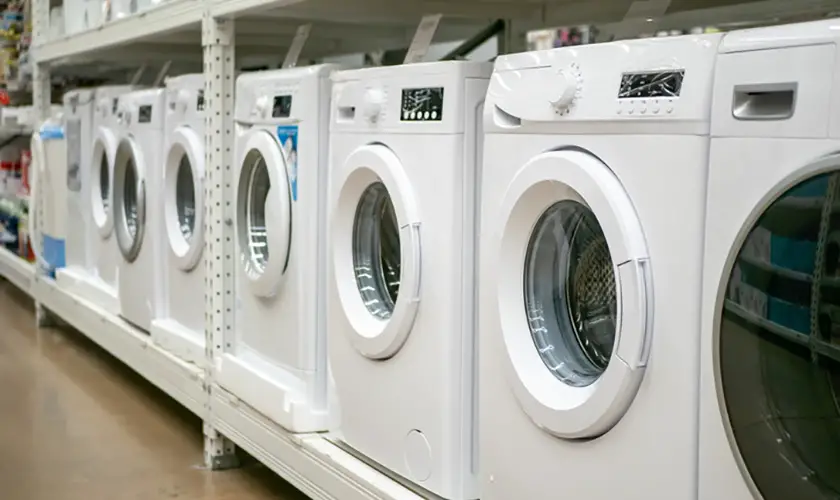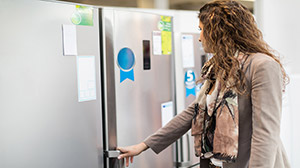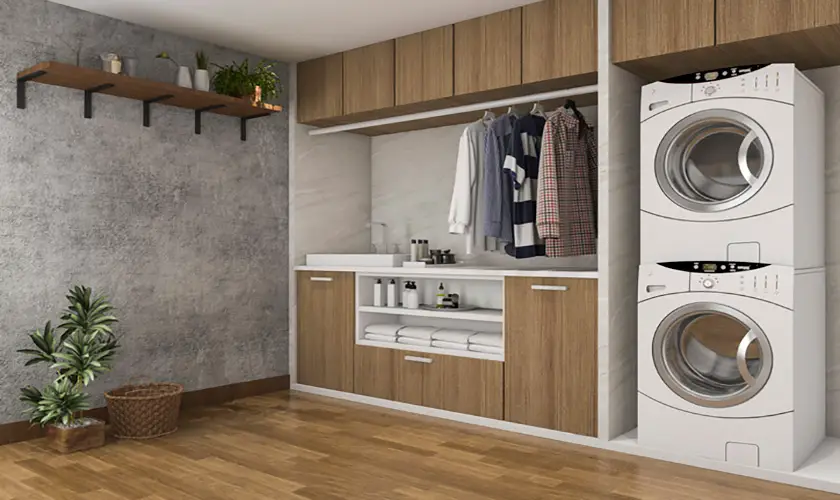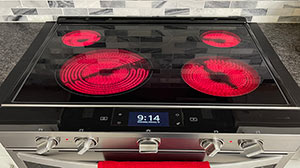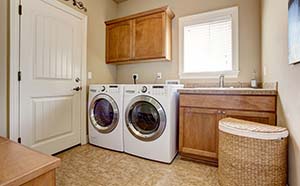What is a heat pump clothes dryer anyway? A heat pump dryer is a next-generation clothes dryer that uses a heat pump to efficiently and effectively dry clothes.
Overall, heat pump electric dryers are a great option for homeowners looking for an efficient, effective, and environmentally friendly way to dry their clothes. Since they do not require venting, heat pump tumble dryers are perfect for condos, apartments, or virtually any place where venting to the exterior is not an option.

What is a Heat Pump Dryer
An electric heat pump clothes dryer uses heat pump technology to remove moisture from wet clothes. Unlike traditional dryers, which vent hot air outside, heat pump dryers recycle hot air and use it to dry clothes, making them much more energy-efficient.
The heat pump in a heat pump tumble dryer works by compressing and expanding refrigerant gas, which in turn heats and cools the air that passes through the dryer. As the air passes through the drum, it absorbs moisture from the clothes, and the resulting humid air is condensed and drained away. The dry air is then reheated and recirculated into the drum to continue drying.
While heat pump dryers can be more expensive than traditional dryers, their energy-efficient operation can result in significant long-term energy savings on utility bills. Additionally, they produce less heat and humidity in the laundry room, making it more comfortable for the user and reducing the risk of mold growth.
Many condenser models have a smaller capacity dryer drum of 4 to 4.4 cubic feet, whereas traditional dryers have a larger drum capacity of 7 to 7.3 cubic feet. Compact dryers also can have longer drying times per laundry load, usually between 55 and 80 minutes.
How Traditional Electric Dryers Work
Traditional dryers use a simple heating element to generate heat and dry clothes. When you turn on a traditional electric dryer, it uses electricity to power the heating element, heating the air inside the drum. The hot air is then blown through the clothes inside the drum, which helps to evaporate the moisture and dry them.
While a regular dryer is effective at quickly drying clothes, they have several drawbacks. For one, they use a lot of energy and can lead to higher energy bills.
In fact, according to the US Department of Energy, a traditional electric dryer can use as much as 3.3 kilowatt-hours of electricity to dry a single load of laundry. This high energy consumption produces higher utility bills and a greater environmental impact.
Another drawback of electric dryers is the high temperature at which they operate. Because they rely on a heating element, they can get very hot, reaching as high as 180 degrees Fahrenheit. This high temperature can damage certain fabrics, causing shrinkage or even damage such as melting or scorching.
Overall, while traditional dryers are effective at getting clothes dry quickly, they have significant drawbacks regarding energy consumption and potential fabric damage. In the next section of this article, we will explore how heat pump dryers work and how they address some of these issues.
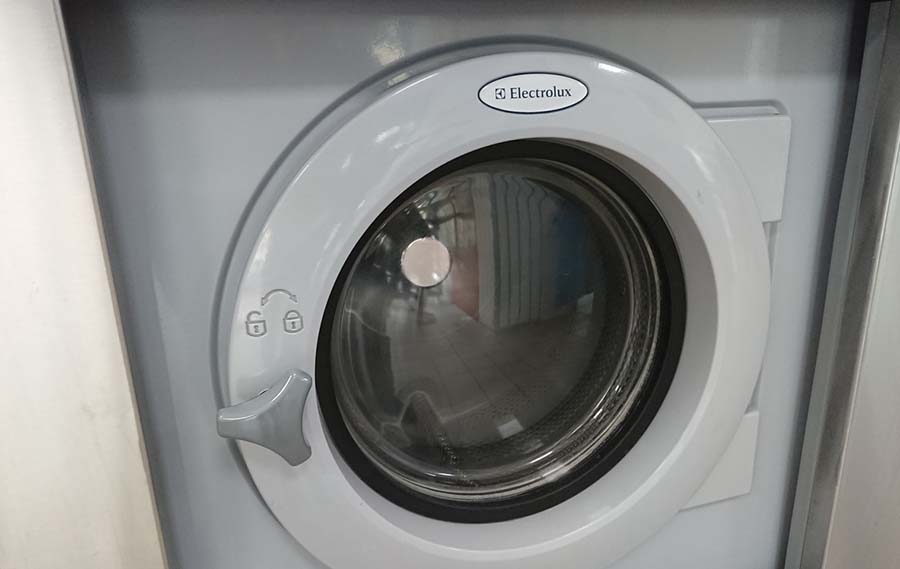
How Heat Pump Dryers Differ From Traditional Dryers
Heat pump clothes dryers use a heat exchanger to efficiently and effectively dry clothes. Instead of relying on a heating element to generate heat, they use a heat pump technology to draw in cool, dry air and pass it over a condenser. The condenser heats the air, passing through the drum to dry clothes.
After the hot air goes through the drum, it is cooled and dehumidified before being recycled into the system. Condensed water drains through a hose or into a collection tank.
This process allows heat pump tumble dryers to operate at much lower temperatures than standard dryers, typically between 120 and 140 degrees Fahrenheit. This lower temperature helps to protect delicate fabrics and reduces the risk of shrinkage or damage to clothing.
One key advantage is that there is no dryer vent to clean and maintain. Ventless dryers have fewer fire hazards than their vented counterparts, as there is no direct route for lint to accumulate, which can cause a fire if it isn’t regularly cleared.
Additionally, ventless dryers are quieter than vented ones since all the noise stays in the home and is not released into the environment, reducing your carbon footprint.
In addition to operating at lower temperatures, heat pump dryers are also much more energy-efficient than standard dryers. Because they rely on a heat pump rather than a heating element, they use less electricity to operate.
According to the US Department of Energy, heat pump dryers can use up to 50% less energy than standard electric dryers.
Heat pump condenser dryers offer a superior drying experience to conventional tumble dryers. They are more energy-efficient, operate at lower temperatures, and are gentler on clothes.
Benefits of Heat Pump Dryers
Heat pump electric dryers offer several benefits over conventional dryers. Here are just a few:
- Energy Efficiency: As mentioned earlier, condenser tumble dryers use less energy than traditional dryers. According to the U.S. Department of Energy, a heat pump dryer can use up to 50% less energy usage than a traditional dryer. Examine Energy Star energy ratings on models before making a purchasing decision. Energy Star is the standard most used for energy ratings on appliances.
- Cost Savings Over Time: Heat pump models may cost more initially than traditional dryers, but they can save you money over time. Because they use less energy, your monthly utility bills will be lower. Additionally, your clothes will last longer because they operate at lower temperatures, so you’ll need to replace them less frequently.
- Better for Your Clothes: Heat pump dryers operate at lower temperatures than traditional dryers, so they are gentler on your clothes. This can help reduce shrinkage and damage, so your clothes will last longer.
- Better for the Environment: Because heat pump dryers use less energy in the drying process than traditional dryers, they are better for the environment. They can help reduce greenhouse gas emissions and conserve natural resources.
The Downside of Heat Pump Dryers
While heat pump dryers offer many benefits, there are also some potential downsides to consider:
- Longer Drying Times: Heat pump dryers are more energy-efficient than traditional dryers but take longer to dry clothes. This is because they use cooler air to dry clothes, which can result in longer cycle times. As a result, users may need to plan their laundry routines accordingly.
- Higher Upfront Cost: Heat pump dryers can be more expensive than traditional dryers. While their energy efficiency can lead to long-term savings on energy bills, the initial investment may be a barrier for some buyers.
- Maintenance Requirements: Heat pump dryers require regular maintenance to ensure they continue to operate efficiently. This may include cleaning the lint filter, checking the condenser unit, and inspecting the heat exchanger. Failure to perform regular maintenance can lead to reduced efficiency and increased risk of breakdowns.
- Limited Capacity: Heat pump dryers tend to have smaller capacities than traditional dryers, which may not be sufficient for larger households or for drying bulky items like comforters or blankets.
- Reliance on Electricity: Heat pump dryers rely solely on electricity, which can be a disadvantage in areas with high electricity costs or frequent power outages. Additionally, their reliance on electricity may not be the best option for off-grid or remote locations.
Heat Pump Clothes Dryer Installation and Maintenance
Heat pump dryers are a great way to save money on energy costs while keeping your clothes clean and dry. Installing a heat pump dryer is relatively easy, but there are some important steps to ensure it is installed correctly.
First, you’ll need to find a suitable location for the dryer. It should be in a well-ventilated area with enough space for the dryer and any necessary hoses or cords. You may also need to consider if you want the dryer to be freestanding or installed onto a washing machine.
Once you have found the right spot, you can begin the installation process. This will involve connecting the power cord, water hose, and drain hose according to the instructions provided in your manual or by an expert. Additionally, ensure that all dryer parts are securely fastened before use.
Finally, it’s important to maintain your heat pump dryer regularly to keep it running efficiently and safely. This includes cleaning out lint filters after each use, checking hoses for signs of wear and tear, and ensuring all components are properly connected. Additionally, read up on any safety precautions your manufacturer recommends before using your heat pump dryer.
By following these simple tips for installing and maintaining your heat pump dryer, you can enjoy many years of efficient drying performance without having to worry about costly repairs or replacements down the line.
Electric Heat Pump Dryer FAQs
Are heat pump dryers better?
Heat pump dryers are generally considered better options than conventional dryers because they use less energy and cost less to operate over time. Heat pump dryers tend to have gentler drying cycles that can be safer for more delicate fabrics.
Does a heat pump dryer need to be vented?
No, heat pump dryers are ventless, meaning they do not require an external vent. They are usually more compact and can be installed in smaller spaces or homes with no way to vent dryer exhaust to the exterior.
Do heat pump dryers use a lot of electricity?
No, heat pump dryers are designed to be energy-efficient and require less energy than traditional dryers. They use a heat exchange system to recycle the air inside the drum, which helps reduce electricity consumption.
Conclusion
In conclusion, heat pump electric clothes dryers offer several benefits over traditional dryers. They are more energy-efficient, operate at lower temperatures, and are gentler on clothes. They can also save homeowners money over time and are better for the environment.
When considering which type of dryer to purchase, it’s important to weigh the benefits and drawbacks of each option. While heat pump dryers may cost more upfront, they can pay for themselves over time with savings on utility bills and extended clothing life.
As a Certified Master Inspector, I recommend choosing a heat pump dryer for your home if you’re looking for an efficient, effective, and environmentally friendly way to dry your clothes. Just be sure to follow proper installation and maintenance procedures to ensure optimal performance and longevity.


